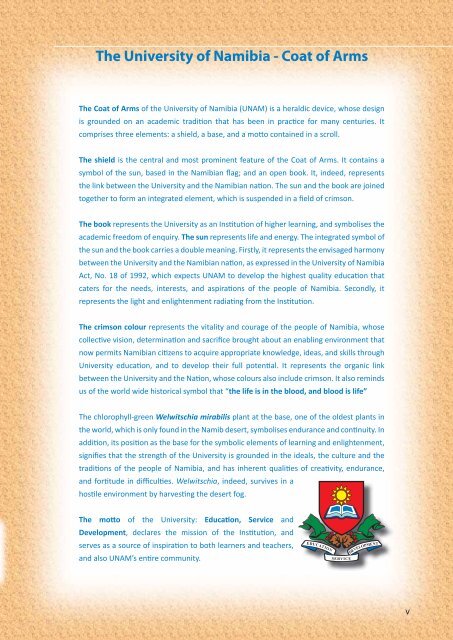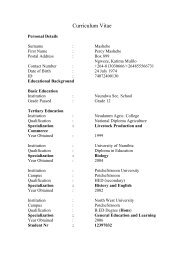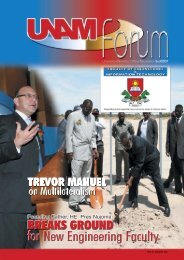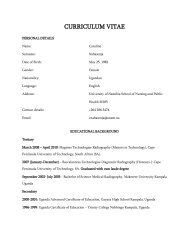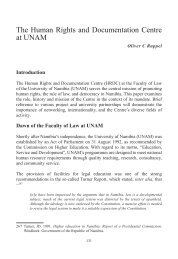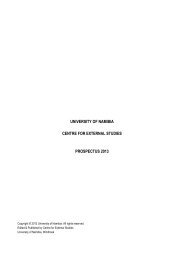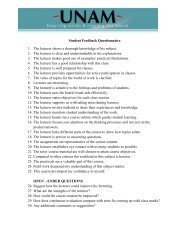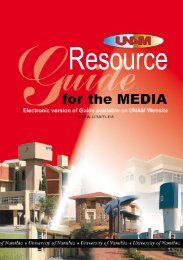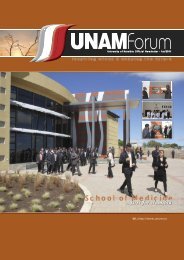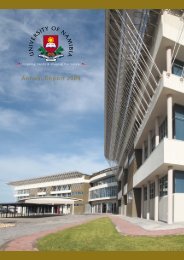Annual Report 2007 - University of Namibia
Annual Report 2007 - University of Namibia
Annual Report 2007 - University of Namibia
- No tags were found...
Create successful ePaper yourself
Turn your PDF publications into a flip-book with our unique Google optimized e-Paper software.
The <strong>University</strong> <strong>of</strong> <strong>Namibia</strong> - Coat <strong>of</strong> ArmsThe Coat <strong>of</strong> Arms <strong>of</strong> the <strong>University</strong> <strong>of</strong> <strong>Namibia</strong> (UNAM) is a heraldic device, whose designis grounded on an academic tradition that has been in practice for many centuries. Itcomprises three elements: a shield, a base, and a motto contained in a scroll.The shield is the central and most prominent feature <strong>of</strong> the Coat <strong>of</strong> Arms. It contains asymbol <strong>of</strong> the sun, based in the <strong>Namibia</strong>n flag; and an open book. It, indeed, representsthe link between the <strong>University</strong> and the <strong>Namibia</strong>n nation. The sun and the book are joinedtogether to form an integrated element, which is suspended in a field <strong>of</strong> crimson.The book represents the <strong>University</strong> as an Institution <strong>of</strong> higher learning, and symbolises theacademic freedom <strong>of</strong> enquiry. The sun represents life and energy. The integrated symbol <strong>of</strong>the sun and the book carries a double meaning. Firstly, it represents the envisaged harmonybetween the <strong>University</strong> and the <strong>Namibia</strong>n nation, as expressed in the <strong>University</strong> <strong>of</strong> <strong>Namibia</strong>Act, No. 18 <strong>of</strong> 1992, which expects UNAM to develop the highest quality education thatcaters for the needs, interests, and aspirations <strong>of</strong> the people <strong>of</strong> <strong>Namibia</strong>. Secondly, itrepresents the light and enlightenment radiating from the Institution.The crimson colour represents the vitality and courage <strong>of</strong> the people <strong>of</strong> <strong>Namibia</strong>, whosecollective vision, determination and sacrifice brought about an enabling environment thatnow permits <strong>Namibia</strong>n citizens to acquire appropriate knowledge, ideas, and skills through<strong>University</strong> education, and to develop their full potential. It represents the organic linkbetween the <strong>University</strong> and the Nation, whose colours also include crimson. It also remindsus <strong>of</strong> the world wide historical symbol that “the life is in the blood, and blood is life”The chlorophyll-green Welwitschia mirabilis plant at the base, one <strong>of</strong> the oldest plants inthe world, which is only found in the Namib desert, symbolises endurance and continuity. Inaddition, its position as the base for the symbolic elements <strong>of</strong> learning and enlightenment,signifies that the strength <strong>of</strong> the <strong>University</strong> is grounded in the ideals, the culture and thetraditions <strong>of</strong> the people <strong>of</strong> <strong>Namibia</strong>, and has inherent qualities <strong>of</strong> creativity, endurance,and fortitude in difficulties. Welwitschia, indeed, survives in ahostile environment by harvesting the desert fog.The motto <strong>of</strong> the <strong>University</strong>: Education, Service andDevelopment, declares the mission <strong>of</strong> the Institution, andserves as a source <strong>of</strong> inspiration to both learners and teachers,and also UNAM’s entire community.v


